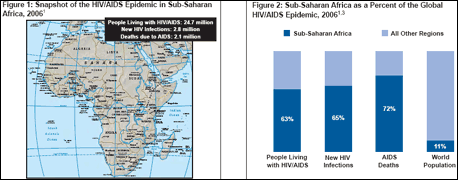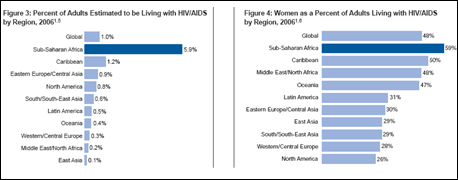
|
The HIV/AIDS epidemic has had its most profound impact to date in Sub-Saharan Africa. The majority of people living with HIV/AIDS (63%), new HIV infections (65%), and AIDS-related deaths (72%) are in this region, which only accounts for 11% of the world’s population.1,2,3 Life expectancy gains over the past century have been halted and in some cases reversed in many of the hardest hit countries in Sub-Saharan Africa, including Botswana, South Africa, Swaziland, Zambia, and Zimbabwe.4 There are more than 5 million people living with HIV in South Africa alone and Swaziland has the highest adult HIV/AIDS prevalence rate (percent of people living with HIV/AIDS)5 in the world.1 Almost all countries in Sub-Saharan Africa have generalized epidemics; that is, their prevalence rates are greater than 1%.1,4 In several nations, more than 10% of adults5 are already estimated to be HIV-positive.4 Women6 make up the majority of those living with HIV/AIDS in the region, and young people are at particular risk.1,4,7 The epidemic has already posed serious development challenges for the region and has affected communities, families, livelihoods, and numerous sectors of society.1 Most countries in the region are lowincome and heavily or moderately indebted, according to the World Bank,8 and other challenges some face include food insecurity, internal migration, and conflict. Yet the epidemic is quite diverse throughout Sub-Saharan Africa and, despite these challenges, there have been success stories, with some countries experiencing stabilization and even reductions in HIV prevalence.1 For example, HIV prevalence has declined among young people over the past several years in 8 of 11 countries with sufficient data to analyze these trends.1 However, the successes are not strong or widespread enough to affect the overall impact on the region. Most countries in the region have developed national responses to HIV/AIDS through National AIDS Commissions, legislation, programs, and services.9,10

Overview
-
The first case of what was later identified as AIDS was officially reported in Africa in 1982.11,12
-
As of the end of 2006, an estimated 24.7 million people were living with HIV/AIDS in Sub-Saharan Africa, representing almost two thirds (63%) of the global total of people living with HIV/AIDS.1
-
The adult HIV/AIDS prevalence rate in Sub-Saharan Africa was the highest of any region in the world (5.9% as of the end of 2006), and significantly higher than the global prevalence rate (1.0%).1,5
-
Of the 4.3 million new HIV infections estimated to occur worldwide in 2006, 2.8 million (65%) were in Sub-Saharan Africa. Also in that year, there were an estimated 2.1 million deaths due to AIDS in the region, or 7 in 10 (72%) of all AIDS-related deaths worldwide.1 HIV is the leading cause of death in Africa.13
-
HIV in Africa is spread primarily through heterosexual sex, although transmission patterns vary across the region and within countries.1
Populations and Regions Affected
-
More African women then ever before are living with HIV and women are more likely than men to be infected with HIV.1,2 Women account for the majority of adults estimated to be living with HIV/AIDS in the region (59%).1,6 The impact on women is even more pronounced in some countries within the region. In Guinea, for example, more than two-thirds (68%) of adults living with HIV/AIDS are women.4
-
Young people are at particular risk; 62% of the world’s young people living with HIV/AIDS are in Sub-Saharan Africa.14 Young women are especially vulnerable, with those aged 15–24 comprising 76% of all young people estimated to be living with HIV/AIDS in Sub-Saharan Africa; in some countries within the region, infection rates are up to 6 times higher among young women compared to men.7,14 As of the end of 2005, the prevalence rate among young women 15–24 in the region was 4.3%, while it was 1.5% for young men in the same age group.4 The impact on young people is exacerbated by the fact that the population of Sub-Saharan Africa is quite young relative to other regions in the world, with 44% of the population below the age of 15 (compared to 29% globally).3
-
Most children15 living with HIV/AIDS are in Sub-Saharan Africa (2.1 million, or 91% of the global total, as of the end of 2006), as are most of the world’s AIDS orphans16 (12.0 million or 79% of the total as of the end of 2005).4,17
-
The epidemic has had a varied impact across the region, with the most severe impact in Southern Africa where one third (32%) of all people with HIV/AIDS worldwide live.1
Other Key Data
-
Knowledge of HIV/AIDS: Studies have found varied levels of general awareness of HIV/AIDS in African countries, as well as persistent examples of misconceptions and stigma.1,4
-
Prevention: Recent estimates indicate that Sub-Saharan Africa faces a significant prevention funding and coverage gap.18,19 For example, in a survey of 12 high prevalence countries in the region, only 12% of men and 10% of women had access to HIV testing services and only 11% of pregnant women with HIV received antiretrovirals for the prevention of mother-to-child transmission of HIV.19
-
Access to Antiretroviral Therapy (ART): Access to ART has dramatically expanded in Sub-Saharan Africa—an estimated 1.3 million people in the region were receiving ART as of December 2006, a more than ten-fold increase since December 2003. Despite this progress, Sub-Saharan Africa faces the greatest need for ART in the world. Only a quarter (28%) of the 4.8 million people living with HIV/AIDS who need ART in the region currently have access to this treatment.19
International Support/Major Donors
-
Numerous donor governments provide funding and other support to address HIV/AIDS in Sub-Saharan Africa, both through regional and country-specific efforts. Sub-Saharan Africa is a major focus of the United States Government’s President’s Emergency Plan for AIDS Relief (PEPFAR), which provides most of its bilateral funding to 15 countries, 12 of which are in Sub-Saharan Africa.20 U.S. bilateral aid for these 12 countries totaled almost $1.5 billion in FY 2006.21 The U.S. also provides funding for HIV/AIDS efforts around the world through its contributions to the Global Fund to Fight AIDS, Tuberculosis and Malaria (The Global Fund).
-
The Global Fund has approved nearly 80 HIV/AIDS grants (including HIV/TB grants) in 38 countries in Sub-Saharan Africa, totaling $2.7 billion in approved funding and representing more than 60% of all Global Fund grants approved in the region.22
-
UNAIDS and its 10 co-sponsors support numerous HIV/AIDS programs, partnerships, and other activities throughout Sub-Saharan Africa.10,23 One of the biggest such funding efforts is the World Bank’s Multi-Country HIV/AIDS Program (MAP) for Africa, launched in 2000; to date, MAP has provided more than $1 billion in grant funding to 29 African countries and 4 sub-regional projects.24

Key Sources/Websites
References:
-
UNAIDS, 2006 AIDS Epidemic Update; December 2006.
-
UNAIDS, “Sub-Saharan Africa,” Fact Sheet; December 2006.
-
Population Reference Bureau, 2006 World Population Data Sheet; 2006.
-
UNAIDS, 2006 Report on the Global AIDS Epidemic; May 2006.
-
Among those between the ages of 15 and 49.
-
Among those aged 15 and over.
-
UNAIDS, 2004 Report on the Global AIDS Epidemic; June 2004.
-
World Bank, “Country Classification:” www.worldbank.org/data/countryclass/countryclass.html.
-
UNAIDS, Countries: http://www.unaids.org/en/Regions_Countries/Countries/default.asp.
-
UNAIDS, UNAIDS at Country-Level: Progress Report; 2004.
-
U.S. Centers for Disease Control and Prevention, “Update: Acquired Immunodeficiency Syndrome (AIDS)—Worldwide”, MMWR, Vol. 37, No. 18; May 13, 1988.
-
Serwadda D et al., “Slim disease: a new disease in Uganda and its association with HTLV-III infection,” The Lancet, Vol. 2; 1985.
-
WHO, The World Health Report 2004—Changing History; May 2004.
-
Kaiser Family Foundation, Fact Sheet: The Global Impact of HIV/AIDS on Youth; July 2004.
-
Under age 15.
-
Aged 0–17, living in 2005.
-
UNAIDS, Core Slides: AIDS Epidemic Update; December 2006.
-
Global HIV Prevention Working Group, Access to HIV Prevention: Closing the Gap; May 2003.
-
WHO/UNAIDS/UNICEF, Towards Universal Access, Scaling Up Priority HIV/AIDS Interventions in the Health Sector, Progress Report; April 2007.
-
The United States President’s Emergency Plan for AIDS Relief: www.pepfar.gov.
-
The United States President’s Emergency Plan for AIDS Relief, The Power of Partnerships: Third Annual Report to Congress on PEPFAR; 2007.
-
The Global Fund: www.theglobalfund.org; as of May 31, 2007.
-
UNAIDS: www.unaids.org.
-
World Bank, “AIDS Regional Update: Africa”: www.worldbank.org/afr/aids/overview.htm.
|
|






